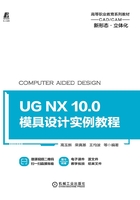
2.3 UG分模实例
2.3.1 片体分模实例
【例2-7】 电动风扇上盖片体分模

电动风扇上盖片体分模
对图2-43所示电动风扇上盖产品进行分模,材料:ABS。

图2-43 产品模型
操作步骤
1)打开配套资源中的ch02/ch02_3/ex1.prt文件。
2)单击工具栏的“缩放体”按钮 ,系统弹出如图2-44所示的“缩放体”对话框,按照图示步骤进行操作,完成产品收缩率的设置。
,系统弹出如图2-44所示的“缩放体”对话框,按照图示步骤进行操作,完成产品收缩率的设置。
3)选择菜单“分析”→“模具部件验证”→“检查区域”,系统弹出如图2-45所示的“检查区域”对话框,单击“计算”按钮 ;然后选择对话框中的“区域”选项卡,系统切换到如图2-46所示界面,按照图2-46所示步骤操作,注意“未定义区域”为0。单击对话框中的“确定”按钮,完成产品体区域面的设置。
;然后选择对话框中的“区域”选项卡,系统切换到如图2-46所示界面,按照图2-46所示步骤操作,注意“未定义区域”为0。单击对话框中的“确定”按钮,完成产品体区域面的设置。

图2-44 “缩放体”对话框

图2-45 “检查区域”对话框1

图2-46 “检查区域”对话框2
4)单击工具栏的“抽取几何特征”按钮 ,系统弹出“抽取几何特征”对话框,按照图2-47所示步骤抽取产品外观面,抽取的面如图2-48所示。
,系统弹出“抽取几何特征”对话框,按照图2-47所示步骤抽取产品外观面,抽取的面如图2-48所示。

图2-47 抽取产品外观面
5)单击工具栏的“拉伸”按钮 ,系统弹出如图2-49所示的“拉伸”对话框,按照图示步骤,选取抽取面的一条边线,创建补片1。
,系统弹出如图2-49所示的“拉伸”对话框,按照图示步骤,选取抽取面的一条边线,创建补片1。

图2-48 产品外观面

图2-49 “拉伸”对话框
6)参照步骤5的操作,创建补片2、补片3和补片4,如图2-50所示。
7)单击工具栏的“桥接曲线”按钮 ,系统弹出如图2-51所示的“桥接曲线”对话框,选取补片1和补片2的外围边线,创建如图2-52所示的桥接曲线。参照此步骤,创建如图2-53所示的另外3条桥接曲线。
,系统弹出如图2-51所示的“桥接曲线”对话框,选取补片1和补片2的外围边线,创建如图2-52所示的桥接曲线。参照此步骤,创建如图2-53所示的另外3条桥接曲线。
8)单击工具栏“通过曲线网格”按钮 ,系统弹出如图2-54所示的“通过曲线网格”对话框,按照图示操作选择“主曲线”和“交叉曲线”,创建如图2-55所示的补片5。照此操作,创建如图2-56所示的补片6、补片7和补片8。
,系统弹出如图2-54所示的“通过曲线网格”对话框,按照图示操作选择“主曲线”和“交叉曲线”,创建如图2-55所示的补片5。照此操作,创建如图2-56所示的补片6、补片7和补片8。

图2-50 补片1

图2-51 “桥接曲线”对话框

图2-52 创建的桥接曲线1

图2-53 创建的桥接曲线2

图2-54 “通过曲线网格”对话框

图2-55 补片2
9)单击菜单栏的“N边曲面”按钮 ,系统弹出如图2-57所示的“N边曲面”对话框,选择产品上的破孔边线,创建补孔片体。
,系统弹出如图2-57所示的“N边曲面”对话框,选择产品上的破孔边线,创建补孔片体。

图2-56 补片3

图2-57 “N边曲面”对话框
10)单击工具栏的“缝合”按钮 ,系统弹出如图2-58所示的“缝合”对话框,选择其中一个补片或曲面作为“目标体”,然后框选整个曲面和片体作为“工具体”,将所有片体和抽取的产品外观面缝合成一整张分型片体。
,系统弹出如图2-58所示的“缝合”对话框,选择其中一个补片或曲面作为“目标体”,然后框选整个曲面和片体作为“工具体”,将所有片体和抽取的产品外观面缝合成一整张分型片体。

图2-58 “缝合”对话框
11)单击燕秀U G模具外挂工具栏的“包容体”按钮 ,系统弹出如图2-59所示的“包容体”对话框,框选整个产品体,设置“默认间隙”为25,创建如图2-60所示的工件毛坯。
,系统弹出如图2-59所示的“包容体”对话框,框选整个产品体,设置“默认间隙”为25,创建如图2-60所示的工件毛坯。
12)单击工具栏的“拆分体”按钮 ,系统弹出如图2-61所示的“拆分体”对话框,选择工件为“目标体”,选择缝合的分型片体为“工具体”,将工件拆分为两个部件。单击燕秀工具栏的“杀参”按钮
,系统弹出如图2-61所示的“拆分体”对话框,选择工件为“目标体”,选择缝合的分型片体为“工具体”,将工件拆分为两个部件。单击燕秀工具栏的“杀参”按钮 移除参数,如图2-62所示的部件为前模芯(型腔)。
移除参数,如图2-62所示的部件为前模芯(型腔)。

图2-59 “包容体”对话框

图2-60 创建工件

图2-61 “拆分体”对话框

图2-62 型腔
13)将产品体显示,单击工具栏的“减去”按钮 ,系统弹出如图2-63所示的“求差”对话框,选择图中箭头指示的部件(此部件为步骤12拆分后分型片体下面的部分)为“目标体”,选择产品体为“工具体”,求差后得到如图2-64所示的后模芯(型芯)。
,系统弹出如图2-63所示的“求差”对话框,选择图中箭头指示的部件(此部件为步骤12拆分后分型片体下面的部分)为“目标体”,选择产品体为“工具体”,求差后得到如图2-64所示的后模芯(型芯)。

图2-63 “求差”对话框

图2-64 型芯
在片体分模中,由于分型面是抽取了产品的外观面,故用分型面拆分工件得到的分型面以上的部分(参考坐标系)为型腔,而分型面以下的部件包含了胶位和型芯,因此还需用产品求差此部件而得到型芯。
14)用图层管理各个部件。将产品体移动到3层,将前模芯移至30层,将后模芯移至50层。将分型片体移至200层。为防止产品模型丢失,在分模前最好将产品体备份一份放于图层中。分模完成后的前、后模芯及产品如图2-65所示。

图2-65 前、后模芯和产品体
2.3.2 “实体+片体”分模实例
【例2-8】 电瓶车充电器上盖实体分模

电瓶车充电器上盖实体分模
对图2-66所示电瓶车充电器上盖产品进行分模,材料:ABS。

图2-66 产品模型
操作步骤
1)打开配套资源中的ch02/ch02_3/ex2.prt文件。
2)单击工具栏的“缩放体”按钮 ,系统弹出“缩放体”对话框,设置收缩率为1.006,完成产品收缩率的设置。
,系统弹出“缩放体”对话框,设置收缩率为1.006,完成产品收缩率的设置。
3)参考例2-4完成产品破孔的实体修补,如图2-67所示。对于图2-67中箭头指示的破孔,用两个实体块进行修补,修补块2后续要做镶件,修补块3的孔位后续设计司筒针。

图2-67 产品破孔实体修补
4)单击工具栏的“抽取几何特征”按钮 ,系统弹出如图2-68所示的“抽取几何特征”对话框,选取图中箭头指示的面(产品分型面位置的6个面),抽取的面如图2-69所示。
,系统弹出如图2-68所示的“抽取几何特征”对话框,选取图中箭头指示的面(产品分型面位置的6个面),抽取的面如图2-69所示。
5)将上一步中抽取的面修改显示颜色,然后利用“缝合”工具将其缝合成一张片体。
6)选择菜单“插入”→“修剪”→“延伸片体”,系统弹出如图2-70所示的“延伸片体”对话框,设置“偏置距离”为40,选取图中箭头指示的边线,单击“应用”按钮创建分型片体。照此步骤,依次选取其余边线创建如图2-71所示的分型片体。在选取边线时,可先选取直边,再选取圆弧边创建延伸片体。

图2-68 “抽取几何特征”对话框

图2-69 抽取面

图2-70 “延伸片体”对话框

图2-71 创建的片体
7)图层管理各对象。将产品移至3层,将图2-67所示的补块1移至91层,补块2移至31层,补块3移至51层。将以上图层打开显示各对象。
8)单击燕秀外挂工具栏的“包容体”按钮 ,系统弹出如图2-72所示的“包容体”对话框,框选整个产品体,设置“默认间隙”为25,创建工件毛坯。
,系统弹出如图2-72所示的“包容体”对话框,框选整个产品体,设置“默认间隙”为25,创建工件毛坯。

图2-72 “包容体”对话框
9)单击工具栏的“减去”按钮 ,系统弹出如图2-73所示的“求差”对话框,选择工件为“目标体”,然后框选所有对象为“工具体”,单击对话框中的“确定”按钮。此步操作是用产品和修补块求差工件而得到胶位。
,系统弹出如图2-73所示的“求差”对话框,选择工件为“目标体”,然后框选所有对象为“工具体”,单击对话框中的“确定”按钮。此步操作是用产品和修补块求差工件而得到胶位。

图2-73 “求差”对话框
10)单击工具栏的“拆分体”按钮 ,系统弹出如图2-74所示的“拆分体”对话框,选择工件为“目标体”,选择创建的分型片体为“工具体”,将工件拆分为前模芯和后模芯。
,系统弹出如图2-74所示的“拆分体”对话框,选择工件为“目标体”,选择创建的分型片体为“工具体”,将工件拆分为前模芯和后模芯。
11)移除参数后,前模芯、产品及后模芯如图2-75所示。将分型片体移至200层,将前模芯移至30层,将后模芯移至50层。

图2-74 “拆分体”对话框

图2-75 创建的前、后模芯
2.3.3 实体分模实例
【例2-9】 小风扇实体分模

小风扇实体分模
对图2-76所示小风扇产品进行分模,材料:ABS。

图2-76 产品模型
操作步骤
1)打开配套资源中的ch02/ch02_3/ex3.prt文件。
2)单击工具栏的“缩放体”按钮 ,系统弹出“缩放体”对话框,设置收缩率为1.006,完成产品收缩率的设置。
,系统弹出“缩放体”对话框,设置收缩率为1.006,完成产品收缩率的设置。
3)单击燕秀外挂工具栏的“包容体”按钮 ,系统弹出图2-77所示的“包容体”对话框,选择图中步骤2箭头指示的面,设置“默认间隙”为50,单击图中步骤4箭头指示的尺寸箭头,在弹出的文本框中输入“-50”,单击“确定”按钮创建如图2-78所示的实体块1。
,系统弹出图2-77所示的“包容体”对话框,选择图中步骤2箭头指示的面,设置“默认间隙”为50,单击图中步骤4箭头指示的尺寸箭头,在弹出的文本框中输入“-50”,单击“确定”按钮创建如图2-78所示的实体块1。

图2-77 “包容体”对话框1
4)单击燕秀外挂工具栏的“包容体”按钮 ,系统弹出图2-79所示的“包容体”对话框,“包容体”的类型选择“包容柱”,选择图中步骤2箭头指示的面,并拖动“ZC”和“-ZC”方向的尺寸箭头至合适尺寸,或单击“ZC”和“-ZC”方向的尺寸箭头并在弹出的文本框中分别输入“12”和“-12”。单击“确定”按钮创建包容柱实体。
,系统弹出图2-79所示的“包容体”对话框,“包容体”的类型选择“包容柱”,选择图中步骤2箭头指示的面,并拖动“ZC”和“-ZC”方向的尺寸箭头至合适尺寸,或单击“ZC”和“-ZC”方向的尺寸箭头并在弹出的文本框中分别输入“12”和“-12”。单击“确定”按钮创建包容柱实体。

图2-78 创建实体块1

图2-79 “包容体”对话框2
5)单击工具栏的“减去”按钮 ,系统弹出如图2-80所示的“求差”对话框,选择上一步创建的“包容柱”为“目标体”,选择产品体为“工具体”,单击对话框的“确定”按钮。
,系统弹出如图2-80所示的“求差”对话框,选择上一步创建的“包容柱”为“目标体”,选择产品体为“工具体”,单击对话框的“确定”按钮。
6)移除参数后,将图2-81中箭头指示的多余实体删除,得到如图2-82所示的实体块2。

图2-80 “求差”对话框1

图2-81 删除体

图2-82 创建实体块2
7)单击工具栏的“拉伸”按钮 ,系统弹出如图2-83所示的“拉伸”对话框,按照图示操作步骤操作,选择其中一个风扇叶片的底部面,单击“确定”按钮创建拉伸实体。照此操作,创建另外2个叶片的拉伸实体。拉伸创建的3个实体块如图2-84所示。
,系统弹出如图2-83所示的“拉伸”对话框,按照图示操作步骤操作,选择其中一个风扇叶片的底部面,单击“确定”按钮创建拉伸实体。照此操作,创建另外2个叶片的拉伸实体。拉伸创建的3个实体块如图2-84所示。

图2-83 “拉伸”对话框
8)将上述步骤创建的实体块1、实体块2和实体块3进行求和,得到如图2-85所示的后模芯。

图2-84 创建实体块3

图2-85 后模芯
9)单击燕秀外挂工具栏的“包容体”按钮 ,系统弹出图2-86所示的“包容体”对话框,按照图中所示步骤操作,选择后模芯上表面,创建厚度为30的方块。
,系统弹出图2-86所示的“包容体”对话框,按照图中所示步骤操作,选择后模芯上表面,创建厚度为30的方块。

图2-86 “包容体”对话框3
10)单击工具栏的“减去”按钮 ,系统弹出如图2-87所示的“求差”对话框,选择上一步创建的方块为“目标体”,然后框选所有对象作为“工具体”,单击对话框中的“确定”按钮,创建前模芯。创建的前模芯如图2-88所示。
,系统弹出如图2-87所示的“求差”对话框,选择上一步创建的方块为“目标体”,然后框选所有对象作为“工具体”,单击对话框中的“确定”按钮,创建前模芯。创建的前模芯如图2-88所示。

图2-87 “求差”对话框2

图2-88 前模芯(型腔)